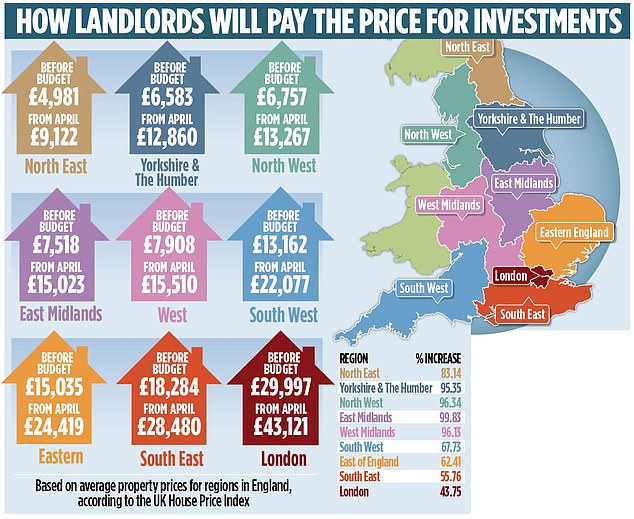How much extra landlords will have to pay under Rachel Reeves’ new double tax – and the regions that will be hardest hit
Finally, a reprieve came for beleaguered landlords when mortgage rates began to fall this year. However, real estate investments are now harder to afford as stamp duty hits them with a double whammy.
Landlords’ stamp duty bills in April could be almost double the amount they were before Chancellor Rachel Reeves’s Budget, Wealth and Personal Finance could reveal this.
Buyers of additional properties in England – including owner-occupied homes and second homes – will have to pay an average of £20,957 from April, according to calculations by the Coventry Building Society.
This is an increase from £12,566 a few weeks ago as landlords now have to pay a higher surcharge, plus the thresholds will be lowered from April. It has the potential to completely change the real estate investing landscape.
These are the stamp duty hotspots where landlords will be hit hardest with upfront costs.
Chancellor Rachel Reeves failed to extend the stamp duty holiday in her October budget
What has changed since the budget?
Second home buyers will now face a 5 per cent surcharge on existing stamp duty rates – up from 3 per cent.
In addition, the Chancellor failed to extend the stamp duty holiday in the Budget, a second blow to landlords, who have enjoyed higher thresholds since 2022.
Stamp duty is payable on homes costing more than £250,000. First-time buyers pay no stamp duty on properties worth less than £425,000.
Rates start at 5 percent and rise to 12 percent depending on the value of the property. Additional property buyers now have to pay an extra 5 percent.
For example, a landlord buying a property worth £309,572 (the average price of a house in England, according to the UK House Price Index) would have paid £12,266 in stamp duty before the budget. At that time, a 3 percent surcharge on top of the existing stamp duty was imposed.
On October 31, after Ms Reeves increased the surcharge to 5 per cent, £18,457 would have been due. The same landlord will have to pay £20,957 from April 1, when the stamp duty holiday ends and the thresholds return. In addition, new rules mean landlords will have to obtain an energy performance certificate (EPC) in band C by 2030, which can also be expensive.

Landlords in the South are confronted with the largest bills
Estate agents have warned that large numbers of landlords could scale back investment or even leave the sector altogether as a result of the increase in the hated tax.
Those who were shocked by the Chancellor’s announcement have already pulled out of the deals after suddenly being forced to find thousands of pounds more to complete the sale within days.
John Hawkesford, of estate agency Hawkesford James in Sittingbourne, Kent, says landlords in his area are already anticipating a squeeze. He knows of seven who filed notices to sell their properties earlier this month.
In addition, he has lost two sales since the Budget as landlords pulled back on investments due to higher upfront costs. “Landlords are so afraid that Labor will come back later with more burdens, so it is seen as time to leave the sector,” he says.
Come spring, buy-to-let investors in the capital will face an average stamp duty bill of £43,121, Coventry BS calculations show.
The calculations took into account the 5 percent surcharge and the reduction in the thresholds. It is based on official average house prices for regions. London has the highest average bill. Before Ms Reeves’ inaugural budget, only £29,997 was due for capital purchases in the capital. Landlords in the South East will face the second highest stamp duty charge after London from April, at £28,480, up from £18,284 a month ago.
In addition, property investors in the east of England will be hit with a £24,419 tax bill from the spring, up from £15,035 before the Budget.
Portfolio and individual landlords will disappear from the real estate world due to the increase, says Ben Perks, director of Orchard Financial Advisers.
He says: ‘I have portfolio landlords who, until a year ago, bought a home at least every three months. Now they have to pay extra taxes, so they are deferred. Casual landlords have no problem with this, because they have to pay extra tax and then have the property taxed on their income.’ The changes could lead to an exodus of landowners to the north, where returns are more attractive.
North and Midlands to see the greatest walks
While landlords in the South will have to pay the highest amount from April, other regions will see the biggest percentage increase in their stamp duty.
Second home buyers in the East Midlands are paying 99.83 per cent more than before the budget.
The county set to see the biggest walk is Greater Manchester. Here, landlords’ stamp duty will rise by 99.14 percent in April. Payments will rise to £14,558 in April, up from £7,311 last month.
Second home buyers in Nottinghamshire will have to pay an average of £14,191 from April, a 98.38 per cent increase on pre-Budget stamp duty.
The West Midlands province follows closely behind with an increase of 98.24 percent.
However, the impact of the stamp duty changes will not only be felt in the regions with the largest bills or percentage increases, as all provinces with available house price data will see their stamp duty rise by more than a third in April.
As a landlord, are you concerned about the increase in stamp duty? Email L.evans@dailymail.co.uk
Some links in this article may be affiliate links. If you click on it, we may earn a small commission. That helps us fund This Is Money and keep it free to use. We do not write articles to promote products. We do not allow a commercial relationship to compromise our editorial independence.
